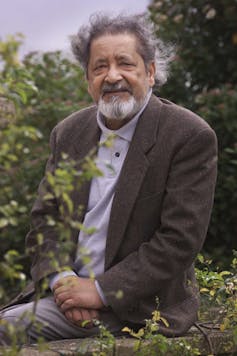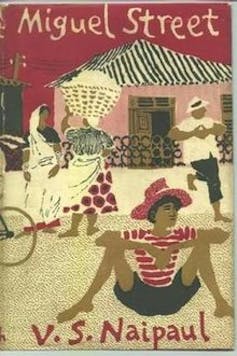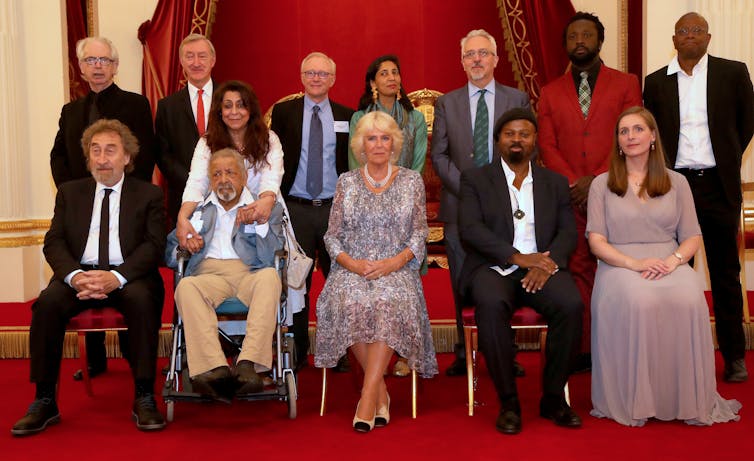Teaching V.S. Naipaul in the Caribbean
- Written by J. Vijay Maharaj, Lecturer, The University of the West Indies: St. Augustine Campus
Like everyone else in the world, people on the twin-island Caribbean nation of Trinidad and Tobago learned on Aug. 11 that Trinidad-born Sir Vidia Naipaul – better known as V.S. Naipaul – had died.
While newspapers in the U.S.[1] and Britain[2] ran tributes to this titan of English-language literature, reactions in the Caribbean have been more complex[3].
Naipaul is perhaps Trinidad’s most famous offspring. But many here consider the 85-year old writer a prodigal son[4], because he often disavowed his origins.
After receiving the Nobel Prize for Literature in 2001, Naipaul claimed[5] England as his “home” and India as the country of his ancestors. He neglected to mention his birthplace and the setting for so much of his work: Trinidad and Tobago.
But Naipaul remains a celebrated part of the Caribbean canon, one of just three Nobel Laureates from the region. In 2007 he even participated in many events at the University of the West Indies, the Caribbean’s premiere public university, when it celebrated what it called The Year of Sir Vidia Naipaul[6].
As a lecturer in literature at the university’s St. Augustine campus[7], it’s my job to help students appreciate his conflicted literary legacy.
Naipaul the decolonizer
Naipaul’s family, like nearly half of Trinidad’s population[8], had Indian roots. Though his early novels were often comedies set in the Caribbean, the author left home to study in England. His later works – bleak reflections on India, Africa and the Muslim world – reflected Naipaul’s global outlook.
Caribbean schoolchildren first meet Naipaul as teenagers. One of his books is usually included in the public secondary school curriculum[9], which is specifically designed to make education a part of the region’s decolonization. Currently it is “A House for Mr. Biswas.”
Fifty-six years after independence from the United Kingdom, the Caribbean is still sloughing off a legacy of colonial rule: the perception that Caribbean culture is less rich, relevant and important than other cultures.
 Naipaul, a complex literary titan.
Chris Ison/PA via AP
Naipaul, a complex literary titan.
Chris Ison/PA via AP
“Silence in our school curriculum on the subject of Caribbean writers raised additional doubts about the literary merit of such works as well as the moral standing of their authors,” wrote the literary critic Rhonda Cobham-Sander[10] in 2007. “[S]o we tended to talk about them, like the uncle who had fled to Venezuela … in the past tense, or the subjunctive.”
Today’s Caribbean curriculum, in contrast, teaches young people to embrace aspects of the local culture once considered embarrassing.
Naipaul, who was born under British colonial rule but came of age writing about the region’s drive for sovereignty, is seen as part of this post-colonial project.
The namesake of Naipaul’s picaresque “A House for Mr. Biswas,”[11] for example, is bent on escape from living with his in-laws, the Tulsis. Even as his lot in life improves with residence in each of the Tulsis’ new homes, Biswas is never satisfied.
As Naipaul’s prologue makes clear, his protagonist is like the Caribbean in that way: He pursues sovereignty and personal freedom at the price of security.
Naipaul in the university
Over the course of their three-year undergraduate education, literature students at the University of the West Indies-St. Augustine may read Naipaul up to six times. Each course puts Naipaul to a different use as it aims to provide students with a different set of skills and competencies.
“A House for Mr. Biswas” again often appears on their first-year “Introduction to Prose Fiction” syllabus.
The short stories from “Miguel Street”[12] may be included in their “West Indian narratives” coursework, and Naipaul’s “A Way in the World”[13] is generally a key text for teaching postmodern literary theory. Advanced literature students may read Naipaul’s Indian trilogy[14] in a third-year class called “Indian Diaspora Literature.”
 For Caribbean readers, Naipaul’s characters — and the humor he derives from them — are immediately recognizable.
Wikipedia[15]
For Caribbean readers, Naipaul’s characters — and the humor he derives from them — are immediately recognizable.
Wikipedia[15]
In my experience, students – especially those from Trinidad and Tobago, who form the majority of St. Augustine’s student body – generally connect immediately and powerfully with Naipaul’s work.
“Miguel Street[16],” for example, often evokes raucous laughter because its characters and events are so instantly recognizable to Caribbean readers.
In recounting her early readings of the book, Cobham-Sander[17], recalls “laughing till I cried at Man Man … and screaming with delight at the idea of his dog leaving symmetrical piles of droppings on the stools in the Café at the corner of Alberto Street where we regularly stopped for sweet drinks.”
Cobham-Sander was also certain that Naipaul’s protagonist Man Man was modeled on a real person – an eccentric neighbor of hers – demonstrating the author’s talent for capturing local daily life.
Naipaul the pop culture creator
As many scholars[18] have asserted, Naipaul’s writing style shares a great deal in common with that most Trinidadian of persons, the calypsonian.
“It is only in the calypso that the Trinidadian touches reality,” Naipaul writes in his long travel essay, “The Middle Passage[19].” “The calypso deals with local incidents, local attitudes, and it does so in a local language. The pure calypso, the best calypso, is incomprehensible to the outsider.”
But, like the traditional “calypsonian,” whose aggressive lyrics often offend[20], Naipaul’s work can raise a reader’s hackles.
This is particularly true of the author’s many nonfictional texts.
In last semester’s advanced seminar in West Indian Literature, I taught “The Middle Passage[21]” – Naipaul’s 1962 attempt to unveil the long-lasting aftereffects of slavery on the the Caribbean[22].
It is Naipaul’s very first travelogue, when he cut his teeth on the form, and it was a government commission. Trinidad’s first-ever prime minister, Eric Eustace Williams, asked the young writer to explore the post-colonial Caribbean and write a critique that would lay a basis for nation-building.
Instead, the devastating tome[23] may well have severed his relationship with the region – and with generations of Caribbean readers to come.
Naipaul’s critics
Among other controversial[24] takes on Caribbean history, “The Middle Passage” includes such indictments as “History is built around achievement and creation; and nothing was created in the West Indies” – this in newly independent region in the midst of rewriting its history.
 A month before his death, Naipaul (in wheelchair, with his wife, Nadira Naipaul) attended a 50th anniversary royal celebration of Britain’s Man Booker Prize for literature.
Gareth Fuller/Pool via Reuters
A month before his death, Naipaul (in wheelchair, with his wife, Nadira Naipaul) attended a 50th anniversary royal celebration of Britain’s Man Booker Prize for literature.
Gareth Fuller/Pool via Reuters
For my students, the book’s reputation as a national betrayal was a real obstacle. Most told me they disliked the text. Some said it was offensive to West Indians.
And that was before they had even read it.
These same students had enthusiastically engaged with similarly difficult questions of slavery, race and Caribbean history in the work of cultural theorist Stuart Hall. His BBC video series “Redemption Song[25]” asserts that whites and blacks lived together on plantations in “a mixture of cruelty and intimacy.”
But, with Naipaul, the students were less amenable to such ideas.
Reconciling Naipaul
The criticism that followed that book[26] is one of the greatest difficulties professors face in teaching Naipaul.
How can we help students see Naipaul’s value as a post-colonial prophet when he so famously spurned the region during its quest to forge an indigenous identity?
How do students reconcile the Caribbean decolonizer they first meet in high school with the Caribbean skeptic they’ll debate as more mature readers?
Naipaul wrote for 60 years. He was knighted[27]. He authored novels, essays and travelogues. He won every literary prize imaginable[28].
He was pandit, calypsonian and knight – a provocateur of different cultural persuasions and a defender of what he believed to be right – sometimes simultaneously, often contradictorily.
To paraphrase the author himself, Naipaul was a complicated man[29] bearing all the complicated strands of his own complicated pasts.
In the Caribbean, accepting this V.S. Naipaul is a task indeed, for teacher and student alike.
References
- ^ U.S. (www.nytimes.com)
- ^ Britain (www.express.co.uk)
- ^ complex (www.indiawest.com)
- ^ prodigal son (www.spectator.co.uk)
- ^ claimed (www.caribbean-beat.com)
- ^ The Year of Sir Vidia Naipaul (sta.uwi.edu)
- ^ lecturer in literature at the university’s St. Augustine campus (sta.uwi.edu)
- ^ half of Trinidad’s population (www.nytimes.com)
- ^ public secondary school curriculum (www.cxc.org)
- ^ Rhonda Cobham-Sander (scholarlyrepository.miami.edu)
- ^ “A House for Mr. Biswas,” (www.theguardian.com)
- ^ “Miguel Street” (www.goodreads.com)
- ^ “A Way in the World” (www.amazon.com)
- ^ Naipaul’s Indian trilogy (www.panmacmillan.com)
- ^ Wikipedia (upload.wikimedia.org)
- ^ “Miguel Street (www.goodreads.com)
- ^ Cobham-Sander (www.amherst.edu)
- ^ many scholars (scholarlyrepository.miami.edu)
- ^ “The Middle Passage (www.cambridge.org)
- ^ lyrics often offend (www.jstor.org)
- ^ The Middle Passage (www.amazon.com)
- ^ the Caribbean (www.youtube.com)
- ^ devastating tome (docs.lib.purdue.edu)
- ^ controversial (www.nytimes.com)
- ^ Redemption Song (bufvc.ac.uk)
- ^ followed that book (www.theatlantic.com)
- ^ knighted (literature.britishcouncil.org)
- ^ every literary prize imaginable (www.theguardian.com)
- ^ a complicated man (www.thehindu.com)
Authors: J. Vijay Maharaj, Lecturer, The University of the West Indies: St. Augustine Campus
Read more http://theconversation.com/teaching-v-s-naipaul-in-the-caribbean-101653


